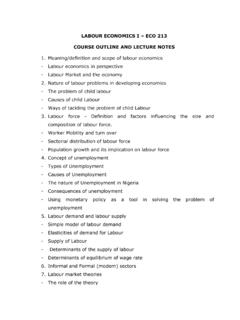Transcription of Socioeconomic Status and Mental Illness: Tests of the ...
1 Socioeconomic Status and Mental illness : Tests of theSocial Causation and Selection HypothesesChristopher G. Hudson, PhDSalem State CollegeThis study Tests several hypotheses about the underlying causal structure of the inverse correlationbetween Socioeconomic Status (SES) and Mental illness . It does this through the analysis of alongitudinal statewide database on acute psychiatric hospitalization in Massachusetts for the fiscalyears 1994 2000 as well as supplemental census data. The modeling strategy used techniques ofstructural equation modeling and found that SES impacted directly on rates of Mental illness aswell as indirectly through the impact of economic hardship on low and middle income of the most consistently replicated findings inthe social sciences has been the negative relationshipof Socioeconomic Status (SES) with Mental Illness: The lower the SES of an individual is, the higher ishis or her risk of Mental illness .
2 Yet there have beenremarkably inconsistent findings concerning thecausal structure of this relationship. Do poor socio-economic conditions predispose people to Mental dis-ability? Or do preexisting, biologically based mentalillnesses result in the drift of individuals into poorsocioeconomic circumstances? Are there particulartypes of conditions whether unemployment , littlefamily support, noisome work conditions, or lack ofautonomy that mediate this effect? Although theguiding assumption of many researchers is that this isan interactive and nonlinear relationship, involvingmultiple conditions and particular types of mentalillness, even the best available longitudinal data setsdo not permit adequate Tests of the relevant there has been such limited progress inunraveling the SES Mental illness relationship, thetrends of the last decade have underscored the im-portance of this issue.
3 Ongoing spending cutbacksand retrenchment in state Mental health programshave highlighted the need for targeting resources tothose areas with the greatest need rather than relyingon simplistic population-based formulas or historicspending patterns. Developments in biological psy-chiatry have led many to diminish the role of socialconditions in the etiology of serious Mental illnessesand the possibilities of early intervention or preven-tion. However, for others, the identification of spe-cific genetic predispositions is seen as an opportunityto better understand the role of particular environ- Mental conditions in triggering these predispositionsor aggravating the course of Mental study, therefore, aims to enhance the field sknowledge of the causal structure of the SES mentalillness relationship.
4 It does this through a structuralequation analysis of two large-scale data sets cover-ing Massachusetts. The Casemix database includesunduplicated records of 109,437 individuals hospital-ized on acute psychiatric units during the fiscal years1994 2000 and thus permits us to track the individ-uals moves among communities over the course oftheir hospitalizations (Massachusetts Division ofHealth Care Finance and Policy [MDHCFP], 1998,2000). Census Bureau (2003) long-form data onthese communities for 2000 then permits us to un-derstand specific community conditions associatedwith differential rates of psychiatric hospitalizationas well as of reported Mental disabilities in of the first studies to identify the inverserelationship between SES and Mental illness was thatof Faris and Dunham (1939), who found dispropor-tionate rates of Mental illness in the poorest parts ofChicago.
5 This was followed by the landmark studiesof Hollingshead and Redlich (1958) in New Haven,Connecticut, and the Midtown Manhattan study(Srole et al., 1977). Whereas the former examinedtreated rates, the later looked at overall communityrates, and both studies found dramatic disparitiesbetween the rates of the lowest and highest socialclasses. One review of the research from 1950 toThis project received partial support from the Office ofAcademic Affairs, Salem State College, and the Wil-liam J. Fulbright reprints and correspondence: Christopher G. Hud-son, PhD, School of Social Work, Salem State College, 352 Lafayette Street, Salem, MA 01945. E-mail: Journal of OrthopsychiatryCopyright 2005 by the Educational Publishing Foundation2005, Vol. 75, No. 1, 3 180002-9432/05/$ DOI: identified 21 studies pertinent to the SES men-tal illness relationship (Dohrenwend, 1980).
6 Whereas 10 of the 15 studies found thehighest rates in the lowest class, 5 of the 6 obtained this same later review, focusing on research of the1980s, not only reported the continued replicationof the core finding but also found that that it heldup regardless of the type of SES indicator used whether education, income, or occupation or thetype of Mental illness examined (Hudson, 1988). Itwas during the 1980s that researchers began to testsome of the competing social causation and socialselection hypotheses, and, also during this period,considerably more evidence accumulated that wassupportive of the social causation some researchers found evidence for therole of the lack of primary (family) or secondary(institutional) supports (Kulka, Veroff, & Douvan,1979), others examined psychosocial factors, suchas the sense of fatalism some low-income individ-uals have (Kohn, 1972), and others focused onspecifically economic factors, such as unemploy-ment.
7 One of the classics in the field was HarveyBrenner s (1973) study of 150 years of hospital-ization and unemployment data in New York thatprovided persuasive evidence of a dramatic impactof unemployment , especially for men, on rates ofpsychiatric the 1990s, research on the SES mentalillness relationship accelerated and focused on theanalysis of large-scale and often longitudinal datasets for the purpose of clarifying the causal struc-ture of the relationship. However, findings fromthis latest wave of research are increasingly of the longitudinal studies have supportedvarious causal pathways involving social causa-tion. One of the strongest was that of Ritsher,Warner, Johnson, and Dohrenwend (2001), whointerviewed 756 participants four times over thecourse of 17 years and found that low parentaleducation was predictive of the risk of depressionfor their offspring, but not the reverse, after con-trolling for parental depression and offspring gen-der and age.
8 Similarly, Link, Lennon, and Dohren-wend (1993) used a New York community samplethat was interviewed twice over 3 years to test thesocial causation and selection hypotheses with de-pression specifically, whether holding an occupa-tion involving direction, control, and planning wasprophylactic. Their data clearly showed that higherstatus occupations involving control and planningwere associated with reduced risk of depressionand that the alternative explanation, involving per-sonality as a common cause of both occupationalchoice and depression, was too ambiguous to beadequately tested but was inconsistent with avail-able evidence. In another prospective cohort studyof 7,725 adults in the United Kingdom, Weich andLewis (1998) found that poverty and unemploy-ment served to increase the duration of episodesbut not the likelihood of their initial occurrence.
9 Incontrast, Link, Dohrenwend, and Skodol (1986)found evidence that initial work in noisome occu-pations preceded and was predictive of the onset ofschizophrenia. A large German study that used across-sectional design found evidence to suggestthat not only low-SES but, specifically, single-parent families were strongly associated with theextent of psychological distress among children(Franz, Kuns, & Schmitz, 2000; Franz, Lensche, &Schmitz, 2002).Also during the last decade, there has been con-tinuing research concluding that social selection maybe an important dynamic in explaining the negativeSES Mental illness correlation. One version of thistheory, often referred to as the geographic drift hy-pothesis, suggests that mentally ill individuals grav-itate to low-income communities as a result of theirdisability, perhaps drawn by lower living costs.
10 Prob-ably the strongest support for this notion came froma study by Dembling, Rovnyak, Mackey, and Blank(2002), who examined geographic migration patternsof 11,725 state psychiatric patients in Virginia overthe course of 18 years. They found a one-third mi-gration rate among counties over the course of thehospitalizations, more often toward lower incomecommunities. However, the effect was more modestthan is portrayed in the researchers narrative, as onlysomewhat over half (56% 59%) moved to commu-nities with less favorable SES characteristics, and byhow much it cannot be determined from the pub-lished report. Two other researchers (Rodgers &Mann, 1993) reanalyzed data from four earlier stud-ies on intergenerational social mobility and foundthat the failure to adequately control for differencesin the cohorts of mentally ill and healthy populationsresulted in an underestimation of the degree of down-ward Socioeconomic drift.
















